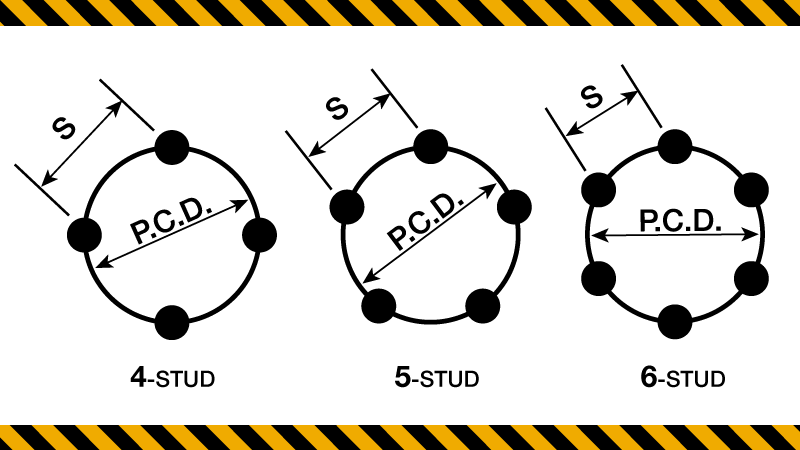Whether you know them as stud, bolt, or lug patterns, knowing your wheel PCD makes finding spare parts a breeze. This guide will help you learn how to identify your stud pattern.
Outline of Topics:
- What does wheel PCD mean?
- Why would I need to know my stud pattern?
- What are standard wheel stud patterns?
- How do I work out my PCD?
- Are wheel hub patterns always the same?
This is the second chapter in the Couplemate™ Technical Hub introduction unit.
What does wheel PCD mean?
Wheel PCD refers to the spacing between your wheel studs. Or rather, the pitch circle diameter of those studs.
Technically, the PCD is the circle diameter that passes through the centre of the wheel studs, wheel bolt holes, wheel rim holes, or any other bolt pattern.
Most caravans and trailers in Australia will have a 4-stud, 5-stud, or 6-stud PCD. When people discuss stud patterns, they’re referring to this particular diameter.
Why would I need to know my stud pattern?
In a nutshell, it helps you understand what wheel parts you need.
This can save you time, money, and needless frustration. For example, if you need to replace a wheel or a wheel hub while on the road, knowing your trailer or caravan PCD is incredibly convenient.
It enables you to quickly find the right replacement, reducing downtime and potential inconveniences during your travels.
What are standard wheel stud patterns?
In our experience, Australian trailers and caravans weighing under 4,500 kg ATM will usually have one of the PCDs listed in the table below (“Common Stud Patterns”).
Some people prefer to have their trailer match their tow vehicle’s PCD, so they only have to carry one spare tyre. This is great for saving space and weight. (As we discussed in the first chapter, wheel offset is critical to keep in mind if this is your goal.)
Common Stud Patterns
| 4 Stud | 5 Stud | 6 Stud |
|---|---|---|
| Barina / Lancer (4 x 100mm) | Landcruiser (5 x 150mm) | Landcruiser (6 x 139.7mm) |
| Cortina (4 x 107.95mm) | Ford (5 x 114.3mm) | Navara (6 x 114.3mm) |
| Holden HT (5 x 107.95mm) | HiAce (6 x 130mm) | |
| Holden HQ (5 x 120.65mm) |
How do I work out my PCD?
You need to know your stud centre measurement to work out your PCD. All it requires is a ruler and your hub or wheel.
Simply take two studs and measure from the centre to the centre (see the letter “S” in the image below).

How to measure wheel hub PCD (“S” for stud centre).
You’ll then need to divide that measurement by a particular number:
- If you have four studs, divide by 0.70711.
- If you have five studs, divide by 0.5878
- If you have six studs, divide by 0.5
Important Note
Most charts and references on caravan wheel patterns will list the pitch circle diameter exactly. This may cause some confusion if you use an approximate measurement.
For example, a wheel has five studs, and its centre measurement is approximately 67mm. The PCD will be 113.98mm (67 divided by 0.5878). However, there are very few spares for a 5 x 113.98mm PCD in the trailer and caravan industry.
Most people will be able to discern that this is “close enough” to a Ford PCD (5 x 114.3mm), but there are instances where point four of a millimetre can make a difference.
This is why it’s essential to benchmark your stud centre measurement before calculating the wheel PCD (and subsequently benchmarking your stud pattern).
Benchmark for Stud Centre Measurements
| 4 Stud | 5 Stud | 6 Stud |
|---|---|---|
| Barina / Lancer (70.71mm) | Land Cruiser (88.17mm) | Land Cruiser (69.85mm) |
| Cortina (76.33mm) | Ford (67.19mm) | Navara (57.25mm ) |
| Holden HT (70.92mm) | HiAce (65.00mm) | |
| Holden HQ (70.55mm) |
N.B. Measurements are listed in the same order as the Common Stud Patterns Table above.
Are wheel hub patterns always the same?
While a single PCD doesn’t change (e.g. a Ford PCD will always be 5 x 114.3mm), two Ford wheel hubs may be different to other depending on their:
- Centrebore (i.e. centre boss),
- Bearing profile, and,
- Wheel studs.

5 stud 70mm equals 119 PCD , ? What wheel pattern is this Ford Holden?
Hello Jacob, Ford is 4.5″, Holden HT is 4.25″, HOlden Commodore is 120mm. Thank you, Steve Wotherspoon